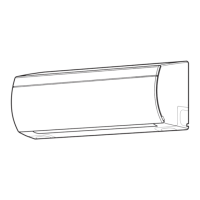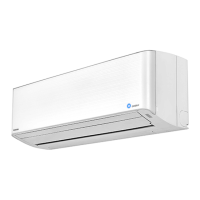Do you have a question about the Toshiba RAS-M16SMUV-E and is the answer not in the manual?
Identifies unit types, models, and general categories like Indoor Unit, Heat Pump, Cooling Only.
Briefly introduces the purpose and content of the owner's manual for the air conditioner.
Lists optional accessories available for purchase with the air conditioner unit.
Comprehensive safety warnings covering installation, operation, and maintenance of the unit.
Specific warnings and confirmations needed during the installation process of the unit.
Important points to remember for safe and effective daily use of the air conditioner.
Details the various physical components of the indoor unit, including grilles and buttons.
Details the various physical components of the outdoor unit, including inlets and outlets.
Explains the meaning of symbols and indicators shown on the remote controller's display.
Details managing multiple units with separate remote controllers for independent operation.
Instructions for inserting and changing batteries in the remote controller for proper function.
Guides on how to set and adjust the current time on the remote controller display.
Advice on positioning the remote for reliable signal transmission to the indoor unit.
Instructions for installing the holder and mounting/removing the remote controller.
How the unit automatically selects cooling, heating, or fan mode based on room temperature.
Details the auto changeover mode for dynamic selection of cooling, heating, or fan operation.
Instructions for operating the unit in cooling, heating, or fan-only modes.
Guidance on using the dry mode for dehumidification purposes and its operation.
How to activate the high power mode for rapid cooling or heating of the room.
Explanation of the ECO timer for setting automatic stop times and energy saving operations.
Step-by-step guide to setting individual ON or OFF timer operations.
Setting a sequence to stop the unit, then restart it later, useful for sleep or departure.
Setting a sequence to start the unit, then stop it later, useful for waking or departure.
How to set combined timers that activate on a daily basis for consistent scheduling.
Instructions on how to cancel any active timer settings to revert to normal operation.
Notes on how the clock display behaves when timers are active, showing time elapsed.
How to manually adjust the direction of the air flow using the FIX button on the remote.
How to activate or deactivate the automatic swinging of the air flow louvers for wider distribution.
Details the logic behind automatic mode selection based on room temperature and conditions.
Explains the operational details and performance characteristics of High Power and ECO modes.
Describes the specific working principles and fan speed usage of the dry operation mode.
Advice for efficient use, including temperature maintenance, filter cleaning, and air circulation.
Instructions for using the unit temporarily without a remote controller, via the RESET button.
Detailed instructions and warnings for cleaning the air filters to maintain performance.
Guidelines for safely cleaning the remote controller without causing damage.
Explains the 3-minute protection function and unit behavior during power failures.
Details preheating, warm air control, defrosting operation, and heating capacity.
Information on heating capacity and precautions for snow/freezing on the outdoor unit.
Important rules and restrictions for re-installing the air conditioner in new locations.
An overview of common problems encountered with the air conditioner and their potential causes.
Steps to check before calling for service, covering basic inoperability and performance.
Explains normal occurrences like odors, mist, indicator behavior, and air flow changes.
Troubleshooting problems with changing settings or signal transmission from the remote controller.
Troubleshoots problems related to display indicators and receiving tones from the indoor unit.
Identifies unit types, models, and general categories like Indoor Unit, Heat Pump, Cooling Only.
Briefly introduces the purpose and content of the owner's manual for the air conditioner.
Lists optional accessories available for purchase with the air conditioner unit.
Comprehensive safety warnings covering installation, operation, and maintenance of the unit.
Specific warnings and confirmations needed during the installation process of the unit.
Important points to remember for safe and effective daily use of the air conditioner.
Details the various physical components of the indoor unit, including grilles and buttons.
Details the various physical components of the outdoor unit, including inlets and outlets.
Explains the meaning of symbols and indicators shown on the remote controller's display.
Details managing multiple units with separate remote controllers for independent operation.
Instructions for inserting and changing batteries in the remote controller for proper function.
Guides on how to set and adjust the current time on the remote controller display.
Advice on positioning the remote for reliable signal transmission to the indoor unit.
Instructions for installing the holder and mounting/removing the remote controller.
How the unit automatically selects cooling, heating, or fan mode based on room temperature.
Details the auto changeover mode for dynamic selection of cooling, heating, or fan operation.
Instructions for operating the unit in cooling, heating, or fan-only modes.
Guidance on using the dry mode for dehumidification purposes and its operation.
How to activate the high power mode for rapid cooling or heating of the room.
Explanation of the ECO timer for setting automatic stop times and energy saving operations.
Step-by-step guide to setting individual ON or OFF timer operations.
Setting a sequence to stop the unit, then restart it later, useful for sleep or departure.
Setting a sequence to start the unit, then stop it later, useful for waking or departure.
How to set combined timers that activate on a daily basis for consistent scheduling.
Instructions on how to cancel any active timer settings to revert to normal operation.
Notes on how the clock display behaves when timers are active, showing time elapsed.
How to manually adjust the direction of the air flow using the FIX button on the remote.
How to activate or deactivate the automatic swinging of the air flow louvers for wider distribution.
Details the logic behind automatic mode selection based on room temperature and conditions.
Explains the operational details and performance characteristics of High Power and ECO modes.
Describes the specific working principles and fan speed usage of the dry operation mode.
Advice for efficient use, including temperature maintenance, filter cleaning, and air circulation.
Instructions for using the unit temporarily without a remote controller, via the RESET button.
Detailed instructions and warnings for cleaning the air filters to maintain performance.
Guidelines for safely cleaning the remote controller without causing damage.
Explains the 3-minute protection function and unit behavior during power failures.
Details preheating, warm air control, defrosting operation, and heating capacity.
Information on heating capacity and precautions for snow/freezing on the outdoor unit.
Important rules and restrictions for re-installing the air conditioner in new locations.
An overview of common problems encountered with the air conditioner and their potential causes.
Steps to check before calling for service, covering basic inoperability and performance.
Explains normal occurrences like odors, mist, indicator behavior, and air flow changes.
Troubleshooting problems with changing settings or signal transmission from the remote controller.
Troubleshoots problems related to display indicators and receiving tones from the indoor unit.
| Brand | Toshiba |
|---|---|
| Model | RAS-M16SMUV-E |
| Category | Air Conditioner |
| Language | English |












